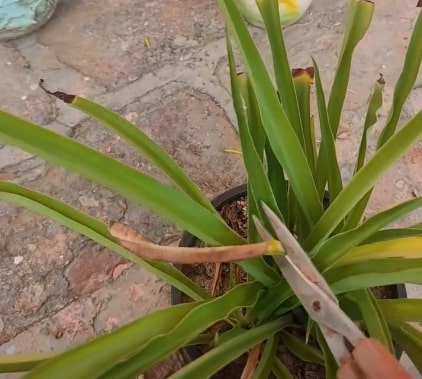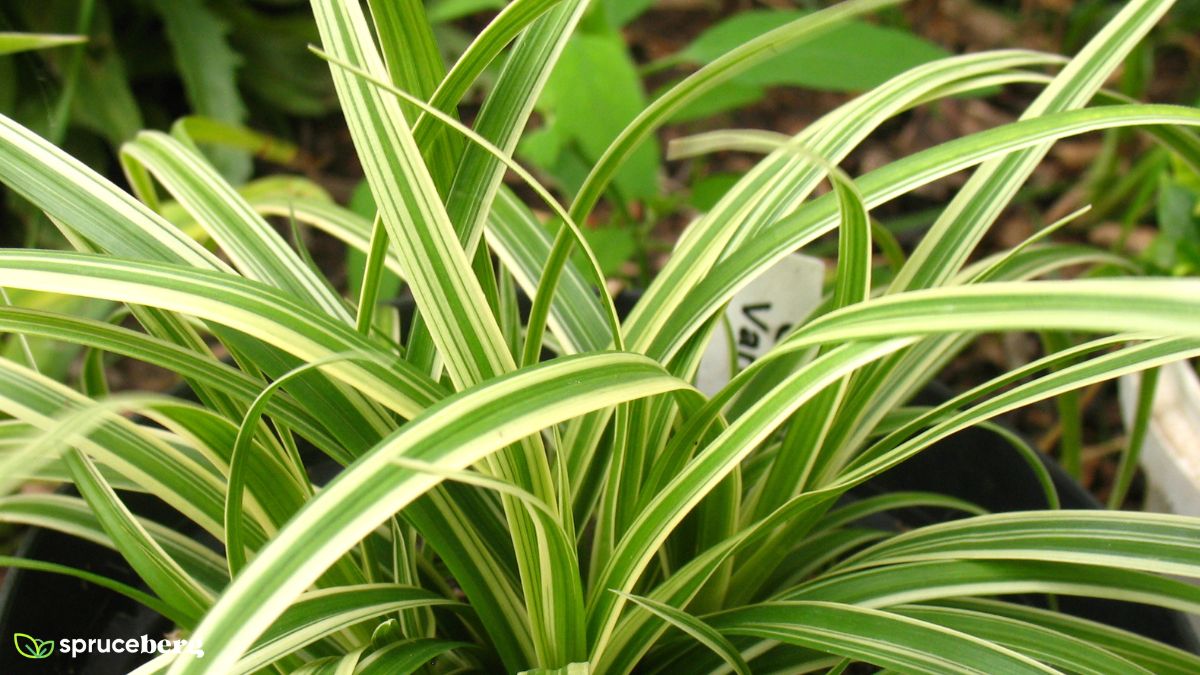Spider plants, scientifically known as Chlorophytum comosum, are popular indoor plants cherished for their air-purifying abilities and low-maintenance nature.
With their arching, variegated leaves, these green beauties add a touch of elegance to any living space. However, as spider plants grow, they can become overgrown or develop unsightly brown or yellow leaves.
That’s where trimming comes in!
In this blog post, we’ll walk you through the simple steps to properly trim your spider plant, helping it flourish and maintain its vibrant appearance. Let’s get started!
The added “Pruning” section highlights the importance of regular pruning for the spider plant’s health and aesthetics, as well as the benefits it brings to encourage new growth and maintain its appearance.
Why should I prune my Spider plant?
Pruning or trimming your spider plant is an essential practice that promotes its overall health and aesthetics. Here are some compelling reasons why you should consider pruning your spider plant:
- Encourages Growth: Regular pruning stimulates new growth by removing old, damaged, or spent foliage. This encourages the plant to direct its energy towards producing fresh, vibrant leaves and offsets, resulting in a fuller, bushier, and more attractive plant.
- Prevents Overcrowding: Spider plants are known for their ability to produce “baby” plantlets, or offsets, which sprout from long stems. Without pruning, these offsets can lead to overcrowding, causing the plant to compete for resources, leading to weaker growth.
- Enhances Appearance: Trimming your spider plant removes brown, yellow, or withered leaves that can mar its appearance. By maintaining a tidy and healthy look, your spider plant becomes a visually appealing addition to your home or office space.
- Promotes Air Circulation: Dense foliage can impede air circulation within the plant, creating a conducive environment for pests and diseases. Pruning opens up the plant, allowing better airflow and reducing the risk of issues caused by stagnant air.
- Controls Size: Spider plants are known for their ability to grow rapidly. Pruning helps to manage their size, preventing them from outgrowing their designated space. This is especially important for indoor plants with limited room to grow.
- Eliminates Unwanted Plantlets: While spider plant offsets can be propagated to create new plants, some people prefer to limit their numbers. Pruning allows you to remove excess plantlets, preventing them from taking over the container or pot.
By regularly pruning your spider plant, you not only maintain its beauty but also ensure its longevity and well-being. It’s a simple and rewarding task that will keep your spider plant thriving for years to come.
When To Trim A Spider Plant?
Knowing the right time to trim your spider plant is crucial to ensure its health and prevent unnecessary stress. Here are the best times to perform trimming:
- Spring: The ideal time to trim your spider plant is during the early spring months, preferably from March to April. At this time, the plant is coming out of its dormancy phase and entering a period of active growth. Trimming during this period encourages new growth and allows the plant to recover more quickly.
- After Flowering: Spider plants occasionally produce small white flowers on long stalks. Once these flowers start to fade and wither, it’s a good time to trim the flower stalks. Removing the spent flower stalks prevents the plant from expending unnecessary energy on seed production.
- Throughout the Year: While the primary pruning is recommended in spring, you can perform light pruning throughout the year if you notice dead or damaged leaves, or if the plant becomes excessively crowded. Regularly removing unhealthy foliage will promote overall plant health.
Remember that spider plants are generally resilient, and minor pruning can be done whenever necessary. However, avoid heavy pruning during winter or the plant’s dormant phase, as it may cause stress to the plant and slow down its growth.
Pruning Tools
- Pruning Shears: Essential handheld cutting tools for precise cuts on small to medium-sized stems.
- Sterilizing Solution: Used to disinfect pruning shears and prevent the spread of diseases.
- Gloves: Protect hands from potential allergens, sap, or thorns.
- Pruning Saw (Optional): For thicker or woody stems that pruning shears can’t handle.
- Disinfectant Wipes: Keep blades clean between cuts to avoid cross-contamination.
- Container or Bag: Collect trimmings for easy cleanup.
With these pruning tools, you’ll be well-equipped to maintain your spider plant’s health and appearance effectively.
Pruning all varieties of spider plants, including Bonnie curly spider plant or Hawaiin spider plants, and pretty simple.
Pruning Yellow Or Brown leaves
Pruning yellow or brown leaves from your spider plant is a vital maintenance practice that contributes to its overall health and aesthetic appeal.
Regularly inspect your plant to identify any leaves that have turned yellow or brown, as these are likely damaged, old, or lacking essential nutrients.
To begin the pruning process, prepare a pair of sharp and clean pruning shears, ensuring they are sanitized to prevent the spread of diseases between plants.
Follow the stem of the discolored leaf down to its base, where it connects to the main stem, and identify the point of emergence.
With a quick and precise motion, make a clean cut at this point, being cautious not to damage the healthy foliage or nearby stems.

Properly dispose of the trimmed leaves to avoid potential pest or disease issues.
After pruning, keep a close watch on your spider plant’s overall health and growth, ensuring it receives adequate watering, appropriate light exposure, and regular fertilization to prevent the recurrence of yellow or brown leaves.
By promptly pruning these leaves, you encourage new growth and help your spider plant maintain its vibrant appearance, ensuring its long-term well-being and beauty.
Prune Foliage At The Base
Pruning foliage at the base of your spider plant is a simple yet effective technique that can greatly contribute to the plant’s health and appearance.
With a pair of sharp and sanitized pruning shears or scissors, locate the base of the unhealthy foliage, where it meets the main stem or central crown.
Make clean cuts at the base to completely remove the undesirable leaves.
Properly dispose of the pruned foliage to prevent potential pest or disease issues. By doing so, you enable your spider plant to channel its energy into producing new, healthier leaves and offsets, leading to a more robust and visually pleasing plant.
Continue to monitor the plant’s health and provide adequate care, including proper watering, lighting, and fertilization, to encourage new growth and maintain the plant’s vitality.
Remember to prune only the unhealthy foliage and avoid over-pruning to preserve the plant’s natural balance and well-being.
Pruning and Propagation
Pruning and propagation go hand in hand when it comes to caring for your spider plant.
Pruning helps maintain the health and appearance of the plant, while propagation allows you to create new spider plants from the offshoots, or plantlets, that the parent plant produces.
Pruning: Pruning involves the removal of dead, yellowing, or unhealthy leaves and stems from your spider plant. By doing so, you promote new growth and prevent the spread of diseases. When pruning, use sharp and sanitized pruning shears to make clean cuts at the base of the undesirable foliage.
Regularly inspect your spider plant and prune as needed to keep it looking vibrant and well-maintained.
Propagation: Spider plants are excellent at producing offsets, or plantlets, which can be easily propagated to create new plants.
To propagate your spider plant, look for healthy and mature plantlets that have grown from the parent plant’s long stems.
- Locate Healthy Plantlets: Look for healthy and mature plantlets that have grown from the parent plant’s long stems.
- Check Root Development: Ensure that the plantlet has developed its own set of roots before attempting propagation.
- Separate the Plantlet: Carefully detach the plantlet from the parent plant by gently cutting or twisting it away.
- Prepare a Pot: Plant the separated plantlet in a small pot filled with well-draining soil, leaving its roots intact.
- Water Lightly: Water the newly propagated plantlet lightly, avoiding overwatering to prevent root rot.
- Provide Optimal Conditions: Keep the new plantlet in a warm and well-lit area to encourage healthy growth.
By following these step-by-step instructions for pruning and propagation, you can maintain the health and appearance of your spider plant while also multiplying its beauty by creating new spider plants from the plantlets it produces.
Regular pruning keeps the parent plant in top condition, and propagation allows you to share the joy of spider plants with others or expand your indoor garden collection.
Pruning Spider Plants: Key Takeaways
| Feature | Description |
|---|---|
| Scientific Name | Chlorophytum comosum |
| Common Names | Spider Plant, Airplane Plant, Ribbon Plant |
| Family | Asparagaceae |
| Origin | Southern and Tropical Africa |
| Growth Habit | Herbaceous Perennial |
| Foliage | Long, arching, narrow leaves with white stripes |
| Flower | Small, white, star-shaped flowers on long stalks |
| Light Requirements | Indirect, bright light; can tolerate low light |
| Temperature | Thrives in average room temperatures (60-75°F) |
| Watering | Moderate watering; keep soil evenly moist but not wet |
| Soil | Well-draining potting mix |
| Pruning | Regular pruning to remove dead or unhealthy leaves, encourage new growth and maintain appearance. |
| Propagation | Easily propagated through plantlets (offsets) |
| Toxicity | Non-toxic to pets and humans |
| Benefits | Air-purifying properties, easy to care for |
Mastering the art of pruning and propagation is the key to cultivating a thriving and visually captivating spider plant.
By carefully pruning yellow or brown leaves and maintaining a tidy appearance, you encourage new growth, prevent diseases, and promote overall plant health.
Additionally, harnessing the power of propagation allows you to multiply the beauty of your spider plant collection and share this delightful green companion with friends and family.
Remember to prune with precision, using sharp and sanitized pruning shears, and choose the right timing for both pruning and propagation.
With these practices at your fingertips, you can confidently care for your spider plant, ensuring it flourishes in its vibrant glory for years to come.
So go ahead, and embrace the journey of nurturing and expanding your spider plant family – it’s a rewarding experience that brings nature’s beauty right into your home. Happy pruning and propagating!

Leave a Reply